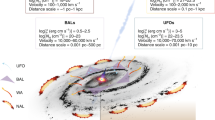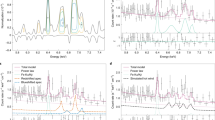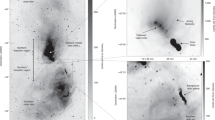Abstract
Supermassive black holes at the centres of galaxies gain mass through accretion disks. Different models predict that quasi-spherical winds, expelled by black holes during accretion, have a key role in galaxy evolution through regulating star formation and the distribution of metals over kiloparsec scales and sweeping ambient gas to the outskirts of galaxies. Nonetheless, the mechanism that drives these outflows and the amount of energy exchanged between the wind and the galaxy’s interstellar medium remain unclear. Here we analyse the kinematic properties of these winds in a sample of nearby active galaxies using the MOKA3D model, which reproduces the clumpy nature of the interstellar medium. We provide evidence that outflows exhibit a regular radial velocity trend—initially constant or slightly decreasing, followed by rapid acceleration starting at approximately 1 kpc from the nucleus—despite the seemingly complex kinematics. The observed behaviour is consistent with current theoretical understanding of active galactic nucleus outflows, where a momentum-driven phase transitions to an energy-conserving phase beyond 1 kpc. The constant velocity of the momentum-driven wind is then rapidly accelerated following inefficient Compton cooling of post-shock material. The measured radial terminal velocities of the outflows are larger than the escape velocities from the host galaxies, confirming the role of outflows in shaping galaxy evolution as a manifestation of active galactic nucleus feedback.
This is a preview of subscription content, access via your institution
Access options
Access Nature and 54 other Nature Portfolio journals
Get Nature+, our best-value online-access subscription
$32.99 / 30 days
cancel any time
Subscribe to this journal
Receive 12 digital issues and online access to articles
$119.00 per year
only $9.92 per issue
Buy this article
- Purchase on SpringerLink
- Instant access to full article PDF
Prices may be subject to local taxes which are calculated during checkout



Similar content being viewed by others
Data availability
All data are public and available on the ESO archive processed data portal at https://archive.eso.org/scienceportal/home.
References
Tombesi, F. et al. Evidence for ultra-fast outflows in radio-quiet AGNs. I. Detection and statistical incidence of Fe K-shell absorption lines. Astron. Astrophys. 521, A57 (2010).
Sturm, E. et al. Massive molecular outflows and negative feedback in ULIRGs observed by Herschel-PACS. Mon. Not. R. Astron. Soc. 733, L16 (2011).
Cicone, C. et al. Massive molecular outflows and evidence for AGN feedback from CO observations. Astron. Astrophys. 562, A21 (2014).
Cresci, G. et al. Blowin’ in the wind: both negative and positive feedback in an obscured high quasar. Astrophys. J. 799, 82 (2015).
Carniani, S. et al. Ionised outflows in z ~ 2.4 quasar host galaxies. Astron. Astrophys. 580, A102 (2015).
Carniani, S. et al. Fast outflows and star formation quenching in quasar host galaxies. Astron. Astrophys. 591, A28 (2016).
Cicone, C. et al. The largely unconstrained multiphase nature of outflows in AGN host galaxies. Nat. Astron. 2, 176–178 (2018).
Harrison, C. M. et al. AGN outflows and feedback twenty years on. Nat. Astron. 2, 198–205 (2018).
Fluetsch, A. et al. Cold molecular outflows in the local Universe and their feedback effect on galaxies. Mon. Not. R. Astron. Soc. 483, 4586–4614 (2019).
Pérez-González, P. G. et al. The stellar mass assembly of galaxies from z = 0 to z = 4: analysis of a sample selected in the rest-frame near-infrared with Spitzer. Astrophys. J. 675, 234–261 (2008).
Fabian, A. C. Observational evidence of active galactic nuclei feedback. Annu. Rev. Astron. Astrophys. 50, 455–489 (2012).
Zubovas, K. & King, A. Clearing out a galaxy. Astrophys. J. Lett. 745, L34 (2012).
Cresci, G. & Maiolino, R. Observing positive and negative AGN feedback. Nat. Astron. 2, 179–180 (2018).
Cano-Díaz, M. et al. Observational evidence of quasar feedback quenching star formation at high redshift. Astron. Astrophys. 537, L8 (2012).
Harrison, C. M., Alexander, D. M., Mullaney, J. R. & Swinbank, A. M. Kiloparsec-scale outflows are prevalent among luminous AGN: outflows and feedback in the context of the overall AGN population. Mon. Not. R. Astron. Soc. 441, 3306–3347 (2014).
Mingozzi, M. et al. The MAGNUM survey: different gas properties in the outflowing and disc components in nearby active galaxies with MUSE. Astron. Astrophys. 622, A146 (2019).
Kakkad, D. et al. Dissecting the active galactic nucleus in Circinus – IV. MUSE-NFM observations unveil a tuning-fork ionized outflow morphology. Mon. Not. R. Astron. Soc. 519, 5324–5332 (2023).
Speranza, G. et al. Multiphase characterization of AGN winds in five local type-2 quasars. Astron. Astrophys. 681, A63 (2024).
Chu, B. R. et al. DUVET: sub-kiloparsec resolved star formation driven outflows in a sample of local starbursting disk galaxies. Mon. Not. R. Astron. Soc. 536, 1799–1821 (2025).
Lai, T. S.-Y. et al. GOALS-JWST: tracing AGN feedback on the star-forming interstellar medium in NGC 7469. Astrophys. J. Lett. 941, L36 (2022).
Crenshaw, D. M. et al. A kinematic model for the narrow-line region in NGC 4151. Astron. J. 120, 1731–1738 (2000).
Das, V. et al. Mapping the kinematics of the narrow-line region in the Seyfert galaxy NGC 4151. Astron. J. 130, 945–956 (2005).
Storchi-Bergmann, T. et al. Feeding versus feedback in NGC 4151 probed with Gemini NIFS – I. Excitation. Mon. Not. R. Astron. Soc. 394, 1148–1166 (2009).
Marconcini, C. et al. MOKA3D: an innovative approach to 3D gas kinematic modelling. I. Application to AGN ionised outflows. Astron. Astrophys. 677, A58 (2023).
Cresci, G. et al. The MAGNUM survey: positive feedback in the nuclear region of NGC 5643 suggested by MUSE. Astron. Astrophys. 582, A63 (2015).
Venturi, G. et al. MAGNUM survey: a MUSE-Chandra resolved view on ionized outflows and photoionization in the Seyfert galaxy NGC1365. Astron. Astrophys. 619, A74 (2018).
King, A. Black holes, galaxy formation, and the MBH-σ relation. Astrophys. J. Lett. 596, L27–L29 (2003).
Ciotti, L. & Ostriker, J. P. Cooling flows and quasars: different aspects of the same phenomenon? I. Concepts. Mon. Not. R. Astron. Soc. Lett. 487, L105–L108 (1997).
King, A. R., Zubovas, K. & Power, C. Large-scale outflows in galaxies. Mon. Not. R. Astron. Soc. 415, L6–L10 (2011).
King, A. R. & Pounds, K. A. Black hole winds. Mon. Not. R. Astron. Soc. 345, 657–659 (2003).
Veilleux, S., Maiolino, R., Bolatto, A. D. & Aalto, S. Cool outflows in galaxies and their implications. Astron. Astrophys. Rev. 28, 2 (2020).
Feruglio, C. et al. The multi-phase winds of Markarian 231: from the hot, nuclear, ultra-fast wind to the galaxy-scale, molecular outflow. Astron. Astrophys. 583, A99 (2015).
Di Matteo, T., Springel, V. & Hernquist, L. Energy input from quasars regulates the growth and activity of black holes and their host galaxies. Nature 433, 604–607 (2005).
Manzano-King, C. M., Canalizo, G. & Sales, L. V. AGN-driven outflows in dwarf galaxies. Astrophys. J. 884, 54 (2019).
Smethurst, R. J. et al. Kiloparsec-scale AGN outflows and feedback in merger-free galaxies. Mon. Not. R. Astron. Soc. 507, 3985–3997 (2021).
Cresci, G. et al. Bubbles and outflows: the novel JWST/NIRSpec view of the z = 1.59 obscured quasar XID2028. Astron. Astrophys. 672, A128 (2023).
Perna, M. et al. GA-NIFS: a galaxy-wide outflow in a Compton-thick mini-BAL quasar at z = 3.5 probed in emission and absorption. Astron. Astrophys. 694, A170 (2025). `.
Ulivi, L. et al. JWST/NIRSpec insights into the circumnuclear region of Arp 220: a detailed kinematic study. Astron. Astrophys. 693, A36 (2025).
Bacon, R. et al. The MUSE second-generation VLT instrument. Proc. SPIE 7735, 773508 (2010).
Marasco, A. et al. Galaxy-scale ionised winds driven by ultra-fast outflows in two nearby quasars. Astron. Astrophys. 644, A15 (2020).
Tozzi, G. et al. Connecting X-ray nuclear winds with galaxy-scale ionised outflows in two z ~ 1.5 lensed quasars. Astron. Astrophys. 648, A99 (2021).
Maiolino, R. & Rieke, G. H. Low-luminosity and obscured Seyfert nuclei in nearby galaxies. Astrophys. J. 454, 95 (1995).
Risaliti, G., Maiolino, R. & Salvati, M. The distribution of absorbing column densities among Seyfert 2 galaxies. Astrophys. J. 522, 157–164 (1999).
Baumgartner, W. H. et al. The 70 month Swift-BAT all-sky hard X-ray survey. Astrophys. J. Suppl. Ser. 207, 19 (2013).
Zanchettin, M. V. et al. NGC 2992: interplay between the multiphase disc, wind, and radio bubbles. Astron. Astrophys. 679, A88 (2023).
Elmouttie, M., Haynes, R. F., Jones, K. L., Sadler, E. M. & Ehle, M. Radio continuum evidence for nuclear outflow in the Circinus galaxy. Mon. Not. R. Astron. Soc. 297, 1202–1218 (1998).
Fischer, T. C. et al. Modeling the outflow in the narrow-line region of Markarian 573: biconical illumination of a gaseous disk. Astron. J. 140, 577–583 (2010).
Müller-Sánchez, F. et al. Outflows from active galactic nuclei: kinematics of the narrow-line and coronal-line regions in Seyfert galaxies. Astrophys. J. 739, 69 (2011).
Bae, H.-J. & Woo, J.-H. The prevalence of gas outflows in type 2 AGNs. II. 3D biconical outflow models. Astrophys. J. 828, 97 (2016).
Venturi, G. et al. MAGNUM survey: compact jets causing large turmoil in galaxies. Enhanced line widths perpendicular to radio jets as tracers of jet-ISM interaction. Astron. Astrophys. 648, A17 (2021).
Fonseca-Faria, M. A., Rodríguez-Ardila, A., Contini, M. & Reynaldi, V. The ionized gas outflow in the Circinus galaxy: kinematics and physical conditions. Mon. Not. R. Astron. Soc. 506, 3831–3852 (2021).
Kakkad, D. et al. BASS XXXI: outflow scaling relations in low redshift X-ray AGN host galaxies with MUSE. Mon. Not. R. Astron. Soc. 511, 2105–2124 (2022).
Venturi, G. et al. Ionized gas outflows from the MAGNUM survey: NGC 1365 and NGC 4945. Front. Astron. Space Sci. 4, 46 (2017).
Durré, M. & Mould, J. The AGN ionization cones of NGC 5728. II. Kinematics. Astrophys. J. 870, 37 (2019).
Shimizu, T. T. et al. The multiphase gas structure and kinematics in the circumnuclear region of NGC 5728. Mon. Not. R. Astron. Soc. 490, 5860–5887 (2019).
Guolo-Pereira, M. et al. Exploring the AGN-merger connection in Arp 245 I: nuclear star formation and gas outflow in NGC 2992. Mon. Not. R. Astron. Soc. 502, 3618–3637 (2021).
García-Bernete, I. et al. Multiphase feedback processes in the Sy2 galaxy NGC 5643. Astron. Astrophys. 645, A21 (2021).
Juneau, S. et al. The black hole–galaxy connection: interplay between feedback, obscuration, and host galaxy substructure. Astrophys. J. 925, 203 (2022).
Tozzi, G. et al. SUPER VIII. Fast and furious at z ~ 2: obscured type-2 active nuclei host faster ionised winds than type-1 systems. Astron. Astrophys. 690, A141 (2024).
Bovy, J. galpy: a python library for galactic dynamics. Astrophys. J. Suppl. Ser 216, 29 (2015).
Girelli, G. et al. The stellar-to-halo mass relation over the past 12 Gyr. I. Standard ΛCDM model. Astron. Astrophys. 634, A135 (2020).
Dutton, A. A. & Macciò, A. V. Cold dark matter haloes in the Planck era: evolution of structural parameters for Einasto and NFW profiles. Mon. Not. R. Astron. Soc. 441, 3359–3374 (2014).
Mowla, L., van der Wel, A., van Dokkum, P. & Miller, T. B. A mass-dependent slope of the galaxy size–mass relation out to z ~ 3: further evidence for a direct relation between median galaxy size and median halo mass. Astrophys. J. Lett. 872, L13 (2019).
Greenhill, L. J., Moran, J. M. & Herrnstein, J. R. The distribution of H2O maser emission in the nucleus of NGC 4945. Mon. Not. R. Astron. Soc. Lett. 481, L23–L26 (1997).
Davis, B. L. et al. The black hole mass function derived from local spiral galaxies. Astrophys. J. 789, 124 (2014).
Wold, M., Lacy, M., Käufl, H. U. & Siebenmorgen, R. The nuclear regions of NGC 7582 from [Ne II] spectroscopy at 12.8 μm – an estimate of the black hole mass. Astron. Astrophys. 460, 449–457 (2006).
Cappellari, M. et al. The mass of the black hole in Centaurus A from SINFONI AO-assisted integral-field observations of stellar kinematics. Mon. Not. R. Astron. Soc. 394, 660–674 (2009).
Caglar, T. et al. LLAMA: the MBH-σ⋆ relation of the most luminous local AGNs. Astron. Astrophys. 634, A114 (2020).
Goulding, A. D., Alexander, D. M., Lehmer, B. D. & Mullaney, J. R. Towards a complete census of active galactic nuclei in nearby galaxies: the incidence of growing black holes. Mon. Not. R. Astron. Soc. 406, 597–611 (2010).
López-Cobá, C. et al. The AMUSING++ nearby galaxy compilation. I. Full sample characterization and galactic-scale outflow selection. Astron. J. 159, 167 (2020).
For, B.-Q., Koribalski, B. S. & Jarrett, T. H. Gas and star formation in the Circinus galaxy. Mon. Not. R. Astron. Soc. 425, 1934–1950 (2012).
Koss, M. J. et al. BAT AGN spectroscopic survey. XX. Molecular gas in nearby hard-X-ray-selected AGN galaxies. Astrophys. J. Suppl. Ser. 252, 29 (2021).
Dahlem, M. et al. The distribution of CO in NGC 4945. Astron. Astrophys. 270, 29–42 (1993).
Dahlem, M. Intergalactic neutral hydrogen gas in the Grus quartet of galaxies. Astron. Astrophys. 429, L5–L8 (2005).
Parkin, T. J. et al. The gas-to-dust mass ratio of Centaurus A as seen by Herschel. Mon. Not. R. Astron. Soc. 422, 2291–2301 (2012).
Lianou, S., Barmby, P., Mosenkov, A. A., Lehnert, M. & Karczewski, O. Dust properties and star formation of approximately a thousand local galaxies. Astron. Astrophys. 631, A38 (2019).
Jorsater, S. & van Moorsel, G. A. High resolution neutral hydrogen observations of the barred spiral galaxy NGC 1365. Astron. J. 110, 2037 (1995).
Morganti, R. et al. The fast molecular outflow in the Seyfert galaxy IC 5063 as seen by ALMA. Astron. Astrophys. 580, A1 (2015).
Acknowledgements
C.M., G.C., A.M., F.M., F.B., E.B. and G.V. acknowledge the support of the INAF Large Grant 2022 ‘The metal circle: a new sharp view of the baryon cycle up to Cosmic Dawn with the latest generation IFU facilities’. C.M., G.C., A.M., G.T., F.M., F.B. and E.B. also acknowledge the support of grant number PRIN-MUR 2020ACSP5K_002 financed by the European Union–Next Generation EU. E.D.T. is supported by the European Research Council (ERC) under grant agreement number 101040751. A.M., F.M. and G.C. acknowledge support from the PRIN-MUR project ‘PROMETEUS’ financed by the European Union–Next Generation EU Mission 4 Component 1 CUP B53D23004750006. S.C. and G.V. acknowledge funding from the European Union (ERC, WINGS, grant number 101040227). G.T. acknowledges financial support from the ERC Advanced Grant under the European Union’s Horizon Europe research and innovation programme (grant agreement AdG GALPHYS, number 101055023).
Author information
Authors and Affiliations
Contributions
C.M. and A.M. designed and coordinated the work, prepared the figures and drafted the manuscript. All authors contributed to the analysis and interpretation of the data, the results and the final text.
Corresponding author
Ethics declarations
Competing interests
The authors declare no competing interests.
Peer review
Peer review information
Nature Astronomy thanks Vincenzo Maineri and the other, anonymous, reviewer(s) for their contribution to the peer review of this work.
Additional information
Publisher’s note Springer Nature remains neutral with regard to jurisdictional claims in published maps and institutional affiliations.
Supplementary information
Supplementary Information
Supplementary Sections 1–3, Figs. 1–16 and References.
Rights and permissions
Springer Nature or its licensor (e.g. a society or other partner) holds exclusive rights to this article under a publishing agreement with the author(s) or other rightsholder(s); author self-archiving of the accepted manuscript version of this article is solely governed by the terms of such publishing agreement and applicable law.
About this article
Cite this article
Marconcini, C., Marconi, A., Cresci, G. et al. Evidence of the fast acceleration of AGN-driven winds at kiloparsec scales. Nat Astron 9, 907–915 (2025). https://doi.org/10.1038/s41550-025-02518-6
Received:
Accepted:
Published:
Issue date:
DOI: https://doi.org/10.1038/s41550-025-02518-6



